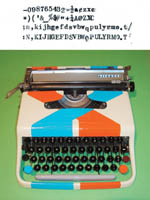Keeping It Old-School: Resuscitating SFMOMA’s Vintage Selectric Typewriter
Business is brisk at California Typewriter, one of the last standing typewriter repair and resale shops. “Every day we have people in here seeking to have a vintage machine made functional again,” says co-owner Carmen Permillion. “Maybe it was a gift from a parent or grandparent. Or they’re a writer, maybe a poet, and they specifically love working non-digitally, either for aesthetic reasons or because it helps them stay focused and not get sucked into email or the Internet. Then there are the movie people—we supplied all the typewriters for the filming of Milk (2008) and Hemingway and Gellhorn (2012), for instance. And of course there are the avid collectors, who are on the hunt for a rare Hermes or Valentine or Contessa and hope we have one, or know how to get one.”

Photo: Eric Sagen
Months ago, in anticipation of the Typeface to Interface exhibition currently on view, SFMOMA’s Architecture + Design curators made videos of a few of the featured machines in action to include in the displays. This was inspired by the department’s expanding philosophy around preserving not just the objects in the collection, but also their functionality and the experience of using them. Along with a first-generation Google Glass and iPhone, the exhibition includes an iconic first-generation IBM Selectric typewriter from 1961.
Designed by Eliot Noyes, the Selectric used a typeball (resembling a golf ball) that rotated and tilted to print the letters on the page, rather than the typebars that had been used in pretty much every model up to that point. Suddenly typebar jams were no longer an issue, and, even better, the typeballs could easily be swapped out to change fonts mid-document.

IBM Selectric Type Styles brochure. Photo: Don Ross
“Technology evolves so rapidly now, that it’s absolutely possible a day will come when museum visitors need to have typewriters explained and demonstrated to them,” reflects Associate Registrar Ashley Dodd. “At SFMOMA we’ve come to realize how important it is to preserve the experience of design. And preparing for this exhibition showed us how challenging it can be to get interactive works in our collection operational due to unsupported software, obsolete technology, and, in the case of the Selectric, extended periods of nonuse.”
Prior to installing the exhibition, a team of curators, conservators, registrars, and preparators checked each of the objects slated to be included. Among other issues, they discovered that the Selectric’s on/off switch wasn’t working. One of the preparators recommended California Typewriter as the place to go for repairs. “It’s not new for us to contract commercial services for art care,” says Dodd. “We only asked that if any parts needed to be replaced, the original parts be kept and returned to us for our Artist Materials Archive. And due to the object’s value, the commercial availability of that particular Selectric, and the professional nature of the shop, we felt comfortable leaving the typewriter there while it was being repaired.” The shop’s owner, Herb Permillion (father of Carmen), was the one who performed the actual repair. Permillion bought California Typewriter in 1981 after having worked for IBM servicing Selectrics for more than a decade. The business has been around since 1949.

Photo: Eric Sagen
The shop is a museum in its own right. Surrounded by auto repair shops, California Typewriter occupies a smallish storefront on San Pablo Avenue in Berkeley. Its walls are lined, floor to ceiling, with typewriters of all makes and models and generations, from the moment of the device’s invention in the 1860s to the height of the Mad Men era, when the muted din of Selectrics, running like the reliable workhorses they were, permeated offices nonstop, eight hours a day.

Photo: Eric Sagen
The Permillions don’t particularly feel that they’re taking an ethical stand against the inexorable forward press of technology, “but many of our clients would certainly tell you that they do,” observes Carmen. Then the stories start: “Do you know there’s a huge market for celebrity-associated typewriters? For instance Cormac McCarthy’s Lettera 32 Olivetti manual was sold at auction in 2009 as a fundraiser for a nonprofit, and it went for $254,500! Or Ian Fleming, the author of the James Bond novels—his gold-plated Royal Quiet Deluxe Portable went for nearly $90,000.”
One of the Permillions’ favorite stories about past clients involves the artist Tauba Auerbach, who came to them with an art project in mind—one that would involve reconfiguring the guts of three typewriters. “I recall she wanted the keys to be upside down on one; and on another she wanted to have it type completely other things when you pressed particular keys,” recalls Herb. “It was going to be so much work that at first we said no, we can’t. But she kept coming back again and again, until finally we agreed to give it a try. That was a really interesting job. It was about communication, or rather cross-communication. We’ve dealt with a lot of artists over the years.”
In case you’re wondering: if you have an old typewriter, the best way to keep it in good working order is to use it at least once a week, says Herb. Otherwise, as with a classic car, its lubricants will dry up and it will need professional attention. Looking to meet fellow typewriter enthusiasts? Consider attending one of the many type-ins that occur on a regular basis around the Bay Area and throughout the country!







